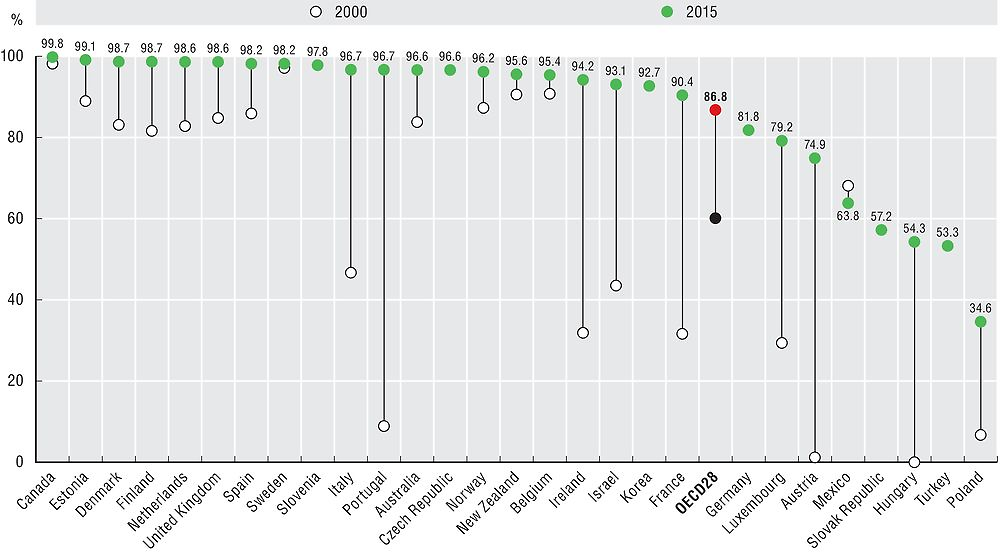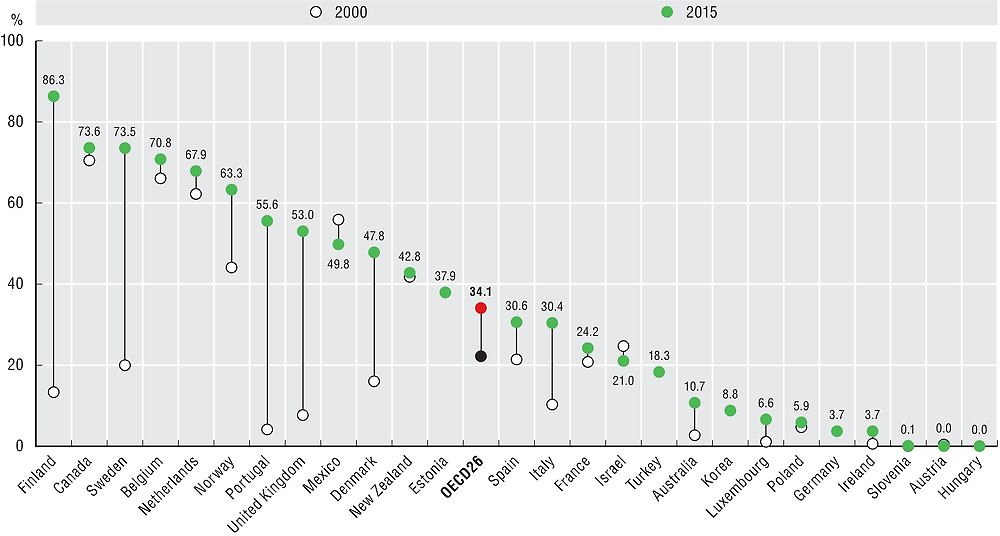Ambulatory surgery
In the past few decades, the number of surgical procedures carried out on a same-day basis has markedly increased in OECD countries. Advances in medical technologies – in particular the diffusion of less invasive surgical interventions – and better anaesthetics have made this development possible. These innovations have improved patient safety and health outcomes, and have also, in many cases, reduced the unit cost per intervention by shortening the length of stay in hospitals. However, the impact of the rise in same-day surgeries on overall health spending may not be straightforward since the reduction in unit cost (compared to inpatient surgery), may be offset by the overall growth in the volume of procedures performed. There is also a need to take into account any additional cost related to post-acute care and community health services following the interventions.
Cataract surgery and tonsillectomy provide good examples of high-volume surgeries which are now carried out mainly on a same-day basis in many OECD countries.
Day surgery now accounts for 90% or more of all cataract surgeries in a majority of OECD countries (Figure 9.22). In several countries, nearly all cataract surgeries are performed as day cases. However, the use of day surgery is still relatively low in Poland, Turkey, Hungary, the Slovak Republic and Mexico, where they still account for less than two thirds of all cataract surgeries. While this may be partly explained by limitations in the data coverage of outpatient activities in hospital or outside hospital, this may also reflect more advantageous reimbursement for inpatient stays or constraints on the development of day surgery.

Source: OECD Health Statistics 2017.
The number of cataract surgeries performed on a same-day basis has grown very rapidly since 2000 in many countries, such as Portugal and Austria (Figure 9.22). Whereas fewer than 10% of cataract surgeries in Portugal were performed on a same-day basis in 2000, this proportion has increased to 97% by 2015. In Austria, the share of cataract surgeries performed as day cases increased from 1% only in 2000 to 75% in 2015. The number of cataract surgeries carried out as day cases has also risen rapidly in many other countries, with many of them carrying out 90% or more cases as ambulatory in 2015.
Tonsillectomy is one of the most frequent surgical procedures on children, usually performed on children suffering from repeated or chronic infections of the tonsils or suffering from breathing problems or obstructive sleep apnea due to large tonsils. Although the operation is performed under general anaesthesia, it is now carried out mainly as a same-day surgery in several countries, with children returning home the same day (Figure 9.23). However, the percentage of cases is not yet as high as for cataract, with a 34% OECD average and a maximum of 86% in Finland. Many countries still lag behind, but show signs of catching up. These large differences in the share of same-day surgery may reflect variations in the perceived risks of postoperative complications, or simply clinical traditions of keeping children for at least one night in hospital after the operation.

Source: OECD Health Statistics 2017.
Financial incentives can affect the extent to which minor surgeries are conducted on a same-day basis. In Hungary, budget caps for same-day surgery financially discouraged the practice. A recent policy change to abolish this budget cap is expected to increase the rates of same-day surgeries for cataracts and other minor surgeries. In Denmark and France, diagnostic-related group (DRG) systems have been adjusted to incentivise same-day surgery. In the United Kingdom, a financial incentive of approximately GBP 300 per case was awarded for selected surgical procedures if the patient was managed on a day-case basis (OECD, 2017).
Cataract surgery consists of removing the lens of the eye because of the presence of cataracts which are partially or completely clouding the lens, and replacing it with an artificial lens. It is mainly performed on elderly people. Tonsillectomy consists of removing the tonsils, glands at the back of the throat. It is mainly performed on children.
The data for several countries do not include outpatient cases in hospital or outside hospital (i.e., patients who are not formally admitted and discharged), leading to some under-estimation. In Ireland, Mexico, New Zealand and the United Kingdom, the data only include cataract surgeries carried out in public or publicly-funded hospitals, excluding any procedures performed in private hospitals (in Ireland, it is estimated that approximately 15% of all hospital activity is undertaken in private hospitals). Data for Portugal relate only to public hospitals on the mainland. Data for Spain only partially include activities in private hospitals.
References
OECD (2017), Tackling Wasteful Spending on Health, OECD Publishing, Paris, https://doi.org/10.1787/9789264266414-en.
